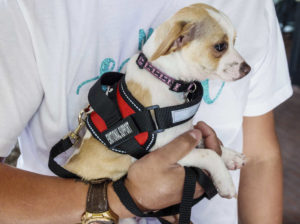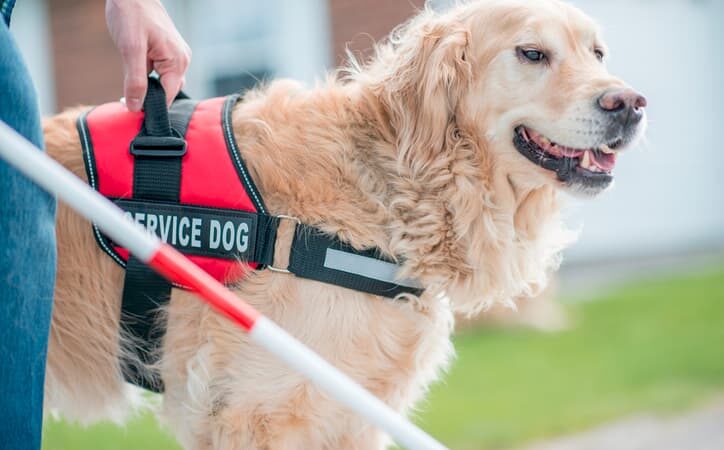By: Eric Anderson
Pre-pandemic I traveled quite frequently, and one thing I started to notice on the airplanes was the number of passengers that were flying with service animals. As a quadriplegic that associates with individuals that use a wheelchair and have sustained a spinal cord injury, I’m familiar with service animals and know from experience that the typical dog breed trained to assist people with disabilities is Labradors, Golden Retrievers, and German Shepherds. Sometimes other smaller breeds of dogs can be trained as a service animal, but it’s rare that you’ll see an actual certified service animal that isn’t one of those three most common breeds listed above. Knowing what I do I thought it was quite suspect when I witnessed a lady enter an airplane I was flying on with a service animal that was small, fluffy, and quite rambunctious. What sparked my curiosity though, was the fact the lady appeared to be completely able-bodied. I didn’t want to immediately jump to conclusions because I’m aware there are people out there with hidden disabilities. Sometimes individuals have service animals that can be trained to alert their owners when they’re about to have a seizure or calm them when a panic or anxiety attack is imminent. However, as I focused intently on this lady’s behavior and treatment of her dog, I started to doubt the validity that it was an actual service animal. My distrust was confirmed shortly after the plane took off and was flying at cruising altitude, and the dog jumped off the women’s lap, walked down the aisle of the plane, squatted, and proceeded to take a poop. The smell was horrific! Passengers were coughing, gagging, complaining to the stewardesses as they cleaned up the mess. Unfortunately, the smell lingered almost the entire duration of the flight – it was terrible. To make matters worse was the complete lack of concern or regret the owner had for what the dog did, she was unapologetic. Service animals don’t poop or pee wherever they want, especially on airplanes. They’re trained not to! A few months later I was travelling to Florida on a flight, and I saw a passenger enter the plane holding a rabbit! Yes, a rabbit as a service animal – how could this be happening I thought to myself?
Emotional Support Animals.
Emotional Support Animals (ESAs) are specifically fitted to improve the day-to-day functionality and well-being of an individual diagnosed typically with a mental disorder such as anxiety, PTSD, depression, or some form of phobia. ESAs can be any type of animal such as a rabbit, hamster, cat, dog, snake, etc., if a doctor has diagnosed a person with a specific medical disorder and officially writes a prescription for an emotional support animal. However, an ESA doesn’t perform any distinct duty or physical task, its purpose is simply to provide comfort to its owner in the form of affection and/or companionship. Furthermore, obtaining a formal prescription for an emotional support animal is generally a simple process – a person can easily purchase a prescription or ESA certification on the internet. So, while there are undoubtedly individuals out there with legitimate emotional support animals, the grey area within the ADA can be abused by pet owners wanting to bring their animals with them when out in public or travelling on airplanes.
Service Animals.

The difference between an emotional support animal and a certified service animal are considerable. A service animal, most commonly a dog, is required to advance through a series of intense training courses that provide them with the necessary skills to serve the medical needs of their owners, while allowing them to perform unique tasks such as opening doors, picking up objects, turning on lights, etc. This type of training is extensive, long, and costly. In fact, the training is so expensive, most people with disabilities with a certified service dog obtained their animals through some form of financial grant or non-profit agency. Before being paired with their owners the animal is tested for its abilities and then officially certified. These animals are highly trained to obey their owners and act in a very disciplined manner when out in public places or travelling on public transportation. They don’t wonder about freely, and they especially don’t poop in the aisle of an airplane.
What The Law Allows.
The Americans with Disabilities Act (ADA) prevents any form of discrimination against disabled persons in various aspects of public life, and has provisions for service animals, granting them access to public places and various forms of public transportation. Because emotional support animals are categorized separately from service animals, they are not granted the same level of coverage. There are laws such as the Fair Housing Act and the Air Carrier Access Act (ACAA), that allow exceptions for emotional support animals; however, the provisions within these laws and verification process are strictly enforced to prevent abuse and exploitation. Ultimately, while emotional support animals are not provided the same protections as service animals under the ADA, there are still laws that safeguard ESA rights. Furthermore, if you are a pet owner wanting to bring your animal into a restaurant or airplane under the guise of an ESA, please be respectful of how your actions will affect those that are truly disabled and require a service or an emotional support animal for their daily living and medical condition.

